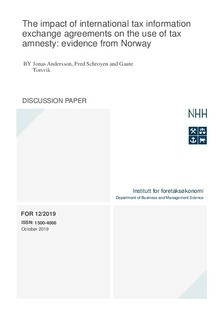The impact of international tax information exchange agreements on the use of tax amnesty: evidence from Norway
Working paper

Åpne
Permanent lenke
http://hdl.handle.net/11250/2620297Utgivelsesdato
2019-10-04Metadata
Vis full innførselSamlinger
- Discussion papers (FOR) [566]
Sammendrag
In this paper we develop a model for tax amnesty applications in a multi-period setting. One key insight from the model is that applying for amnesty becomes more attractive at the moment when stricter enforcement is announced, even if the implementation of the policy is in the distant future. We use our model to make sense of how international tax information exchange agreements affects voluntary disclosure of wealth and income previously hidden in tax havens. Our data is from Norway. In accordance with the dynamic amnesty model we observe a strong announcement effect of a tax information exchange agreement between Norway and Switzerland and Luxembourg, the two most important tax havens for Norwegian tax evaders. However, the effect levels off very quickly, much faster than our model predicts. We think this is because the initial announcement of the tax agreement exaggerated the risk the agreement imposed to those who had hidden taxable income and wealth in Switzerland. We also estimate and find significant effects of the press releases the Norwegian Tax Authority issues to inform taxpayers about new international tax agreements and the amnesty, or voluntary disclosure, option that exists in the Norwegian tax code.